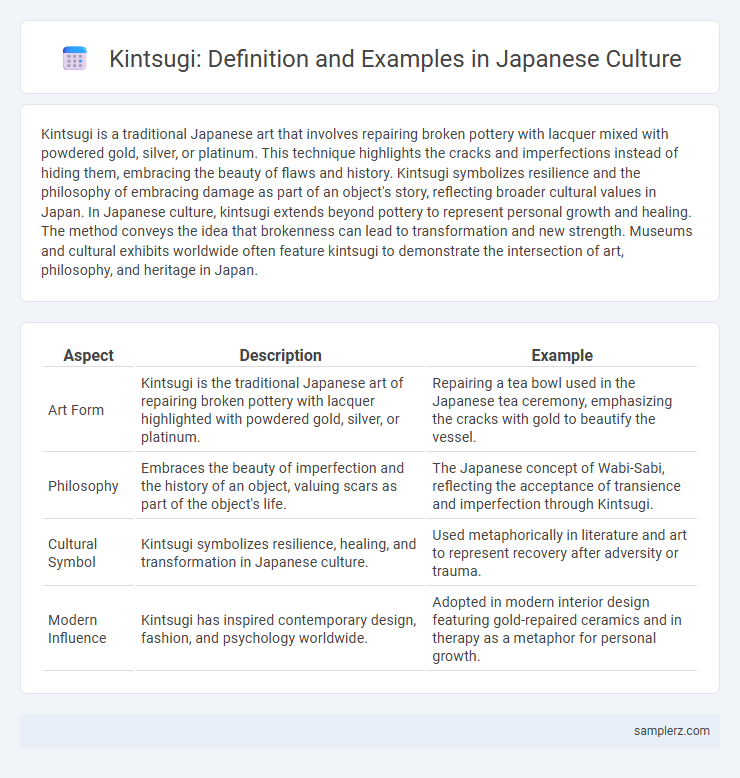Kintsugi is a traditional Japanese art that involves repairing broken pottery with lacquer mixed with powdered gold, silver, or platinum. This technique highlights the cracks and imperfections instead of hiding them, embracing the beauty of flaws and history. Kintsugi symbolizes resilience and the philosophy of embracing damage as part of an object's story, reflecting broader cultural values in Japan. In Japanese culture, kintsugi extends beyond pottery to represent personal growth and healing. The method conveys the idea that brokenness can lead to transformation and new strength. Museums and cultural exhibits worldwide often feature kintsugi to demonstrate the intersection of art, philosophy, and heritage in Japan.
Table of Comparison
| Aspect | Description | Example |
|---|---|---|
| Art Form | Kintsugi is the traditional Japanese art of repairing broken pottery with lacquer highlighted with powdered gold, silver, or platinum. | Repairing a tea bowl used in the Japanese tea ceremony, emphasizing the cracks with gold to beautify the vessel. |
| Philosophy | Embraces the beauty of imperfection and the history of an object, valuing scars as part of the object's life. | The Japanese concept of Wabi-Sabi, reflecting the acceptance of transience and imperfection through Kintsugi. |
| Cultural Symbol | Kintsugi symbolizes resilience, healing, and transformation in Japanese culture. | Used metaphorically in literature and art to represent recovery after adversity or trauma. |
| Modern Influence | Kintsugi has inspired contemporary design, fashion, and psychology worldwide. | Adopted in modern interior design featuring gold-repaired ceramics and in therapy as a metaphor for personal growth. |
Origins of Kintsugi: A Brief Historical Context
Kintsugi originated in the late 15th century during Japan's Muromachi period, embodying the Zen Buddhist philosophy that imperfections hold beauty and value. This art form emerged when a shogun repaired a broken Chinese tea bowl with lacquer dusted with gold, transforming a flawed object into a treasured piece. Kintsugi symbolizes resilience and acceptance, reflecting the Japanese cultural emphasis on harmony, impermanence, and the aesthetics of wabi-sabi.
Philosophical Foundations: Embracing Imperfection
Kintsugi exemplifies the Japanese philosophy of wabi-sabi, which embraces the beauty of imperfection and transience by repairing broken pottery with lacquer mixed with powdered gold. This practice transforms damage into a unique and valuable feature, symbolizing resilience and acceptance of flaws as integral to the object's history. Rooted in Zen Buddhism, kintsugi encourages mindfulness and the appreciation of impermanence, fostering a deeper cultural reverence for life's imperfections.
Traditional Techniques in Kintsugi Art
Kintsugi is a traditional Japanese art form that involves repairing broken pottery with lacquer mixed with powdered gold, silver, or platinum, emphasizing the beauty of imperfections instead of hiding them. This technique reflects the philosophy of wabi-sabi, celebrating the transient and imperfect nature of objects. Master artisans meticulously apply multiple layers of urushi lacquer followed by precious metal dust, creating unique, shimmering cracks that enhance the aesthetic and cultural value of the ceramic piece.
Symbolism of Brokenness and Repair
Kintsugi, the Japanese art of repairing broken pottery with lacquer mixed with powdered gold, silver, or platinum, symbolizes the beauty in imperfection and the strength found in healing. This practice reflects the cultural philosophy of wabi-sabi, embracing flaws and highlighting the history of an object rather than disguising damage. Kintsugi teaches that brokenness and repair can create unique beauty, turning defects into valuable marks of resilience.
Kintsugi in Japanese Ceramics: Iconic Examples
Kintsugi, the Japanese art of repairing broken ceramics with lacquer dusted or mixed with powdered gold, silver, or platinum, exemplifies the cultural philosophy of embracing imperfection and history. Iconic examples include tea bowls (chawan) used in traditional Japanese tea ceremonies where cracks are transformed into visually striking veins of gold, enhancing the object's beauty and narrative. This technique not only restores functionality but also elevates the ceramic piece into a unique work of art, symbolizing resilience and the passage of time.
Kintsugi as a Metaphor in Literature and Folklore
Kintsugi symbolizes resilience and transformation in Japanese literature and folklore, illustrating how brokenness can lead to new beauty and strength. Stories often use the repaired pottery technique as a metaphor for healing emotional wounds and embracing imperfections. This cultural motif enriches narratives by highlighting the value of recovery and the acceptance of life's inevitable fractures.
Contemporary Interpretations of Kintsugi
Contemporary interpretations of kintsugi in Japanese culture extend beyond traditional pottery repair to symbolize resilience and beauty in imperfection across various art forms. Modern artists incorporate kintsugi techniques into ceramics, fashion, and digital design, emphasizing the philosophy of embracing flaws and history. This cultural evolution reflects a growing global appreciation for mindful restoration and sustainable creativity.
Kintsugi-Inspired Practices in Modern Japanese Society
Kintsugi-inspired practices in modern Japanese society reflect a deep appreciation for imperfection and resilience, emphasizing repair as a form of beauty rather than concealment. Contemporary artisans and designers incorporate kintsugi techniques and aesthetics in ceramics, fashion, and even digital art, promoting sustainability by valuing restoration over replacement. This cultural trend intersects with mindfulness and wabi-sabi philosophies, encouraging acceptance of transience and the unique history embodied in repaired objects.
Kintsugi in Japanese Aesthetics: Wabi-Sabi Connection
Kintsugi, the traditional Japanese art of repairing broken pottery with gold lacquer, exemplifies the wabi-sabi aesthetic by embracing imperfection and transience. This technique transforms damage into beauty, highlighting the history and unique character of each object rather than concealing it. Kintsugi reflects a cultural philosophy that values authenticity, resilience, and the passage of time in Japanese aesthetics.
Influence of Kintsugi on Global Art and Culture
Kintsugi, the Japanese art of repairing broken pottery with gold, has profoundly influenced global art by symbolizing resilience and embracing imperfection. This technique inspires contemporary artists worldwide to incorporate the philosophy of beauty in flaws, shaping design, fashion, and visual arts. Museums and galleries increasingly showcase kintsugi works, highlighting its impact on cross-cultural aesthetics and sustainable art practices.

example of kintsugi in Japanese culture Infographic
 samplerz.com
samplerz.com